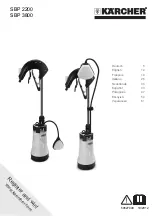
7-4
Saginomiya (Model SKM) Recording Thermometer
Structural/Accessory Maintenance
CSR-20 & CSR-40, September 1999
7.
If the recorder needs recalibration:
a.
Loosen the Allen setscrew (S) using a small slotted
screwdriver.
b.
Adjust shaft (J) with a 5 mm (3/16 in.) open end
wrench until the recording stylus pointer is aligned to
the temperature reading that agrees with the “RET”
controller display. To decrease the stylus temperature
reading, turn the shaft to the left (clockwise). To
increase the reading, turn the shaft to the right (coun-
terclockwise).
c.
Tighten Allen setscrew (S).
d.
Wait another 5 minutes while the unit operates on
Cool. Verify that the recording thermometer reading
is stable and agrees with the “RET” temperature in
the controller display.
e.
Press any key to unlock the controller display screen.
Element Replacement
The recording thermometer’s thermal element is field replace-
able. To replace the element:
1.
Remove element flange screws (D) and withdraw the ther-
mal element from the recorder case. Care must be taken
not to bend the hex shaft which extends from the recorder
case.
2.
Remove the old sensing bulb and capillary from the unit.
3.
Install the new sensing bulb and capillary in the unit. The
capillary of the new thermal element may be bent, but DO
NOT bend the bulb.
4.
Install a new thermal element in the recorder case.
3.
Replace the element flange screws (D) and tighten secure-
ly.
4.
Check the calibration of the recorder. Recalibrate the
recorder if necessary.
Saginomiya (Model SKM) Recording
Thermometer (Option)
The 31-day Saginomiya Recorder is electric motor driven by a
dry cell type battery with a 1 year life expectancy. The sensor
bulb is mounted in the evaporator to record the return air tem-
perature.
The recording thermometer should be inspected and
cleaned to ensure that the stylus produces smooth clean lines
and records accurate temperature readings.
Battery
The recording chart is driven by a battery-powered quartz
motor and reducing gear. The battery charge should be
checked during unit pretrip inspection or once a month. To
check the battery charge, press the button the voltage indica-
tor:
• Blue Zone — Battery good. If the indicator needle remains
in the blue zone when the test button is depressed, the battery
has sufficient power to operate the recorder.
• White Zone — Replace battery within 30 days. If the indica-
tor needle remains in the white zone when the test button is
depressed during a pretrip inspection, replace the battery.
Although the battery may operate the recorder up to 30 more
days, replacing the battery before it is completely dead is rec-
ommended.
• Red Zone — Dead battery. If the indicator needle remains in
the red zone when the test button is depressed, the battery is
dead and must be replaced.
To replace the battery:
1.
Raise the stylus away from the chart by rotating the pen
lift gear clockwise 30 degrees and releasing the lifting
arm. The pen will remain in the raised position. Remove
the knurled chart nut from the drive shaft and remove the
chart.
2.
Loosen the four setscrews that hold the recording platen in
the recorder. The setscrews do not remove from the
recorder base.
3.
Rotate the recording platen counterclockwise and remove
the platen.
4.
Remove the battery from the recorder.
5.
Install a new battery in the recorder making sure the bat-
tery’s positive (+) and negative (-) poles are correctly
aligned.
6.
Press the button on the voltage indicator to make sure the
indicator needle is the in blue zone.
















































